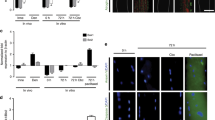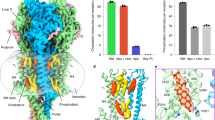Abstract
IN most vertebrate skeletal muscles only the endplate region of muscle membrane is sensitive to acetylcholine (ACh), but after denervation the entire extrajunctional membrane becomes sensitive1,2. In rat diaphragm fibres the degree of extrajunctional ACh sensitivity increases steadily during the 7–9 d following denervation and then remains relatively constant at a high level for at least several weeks. It has been shown that this increase in ACh sensitivity results from the appearance of new ACh receptors in the extrasynaptic membrane3,4, and an intriguing question is whether in already fully supersensitive fibres new ACh receptors continue to appear in the surface membrane. α-Bungarotoxin (α-BuTX) blocks the depolarising action of ACh on supersensitive muscle membrane4, and is thought to bind specifically and almost irreversibly to ACh receptors. Thus one can block all or most receptors of super-sensitive muscle fibres at a certain time. I report here experiments in which the reappearance of extrajunctional ACh sensitivity was followed after blocking sensitivity with α-BuTX, using denervated rat diaphragm muscle, maintained in organ culture5.
This is a preview of subscription content, access via your institution
Access options
Subscribe to this journal
Receive 51 print issues and online access
$199.00 per year
only $3.90 per issue
Buy this article
- Purchase on Springer Link
- Instant access to full article PDF
Prices may be subject to local taxes which are calculated during checkout
Similar content being viewed by others
References
Axelson, J., and Thesleff, S., J. Physiol., Lond., 147, 178–193 (1959).
Miledi, R., J. Physiol., Lond., 151, 1–23 (1960).
Fambrough, D. M., Science, 168, 372–373 (1970).
Miledi, R., and Potter, L. T., Nature, 233, 599–602 (1971).
Miledi, R., and Trowell, O. A., Nature, 194, 981–982 (1962).
Purves, D., and Sakmann, B., J. Physiol., Lond., 237, 157–182 (1974).
Lapa, A. J., Albuquerque, E. X., and Daly, J., Expl Neurol., 43, 375–398 (1974).
Manchester, K. L., Nature, 216, 394–395 (1967).
Kimura, M., and Kimura, I., Nature new Biol., 241, 114–115 (1973).
Grampp, W., Harris, J. B., and Thesleff, S., J. Physiol., Lond., 221, 743–754 (1972).
Hartzell, H. C., and Fambrough, D. M., Devl Biol., 30, 153–165 (1973).
Berg, D. K., and Hall, Z. W., Science, 184, 473–475 (1974).
Chang, C. C., and Huang, M. C., Nature, 253, 643–644 (1975).
Author information
Authors and Affiliations
Rights and permissions
About this article
Cite this article
SAKMANN, B. Reappearance of extrajunctional acetylcholine sensitivity in denervated rat muscle after blockage with α-bungarotoxin. Nature 255, 415–416 (1975). https://doi.org/10.1038/255415a0
Received:
Accepted:
Issue Date:
DOI: https://doi.org/10.1038/255415a0
Comments
By submitting a comment you agree to abide by our Terms and Community Guidelines. If you find something abusive or that does not comply with our terms or guidelines please flag it as inappropriate.



